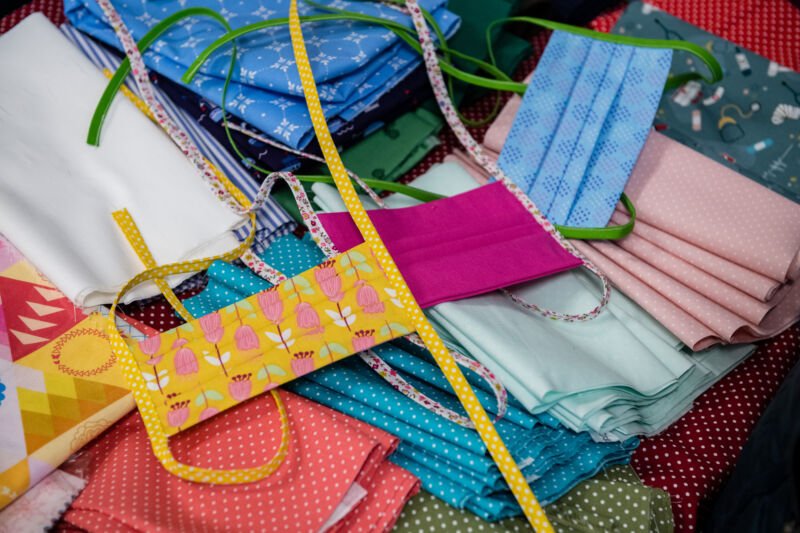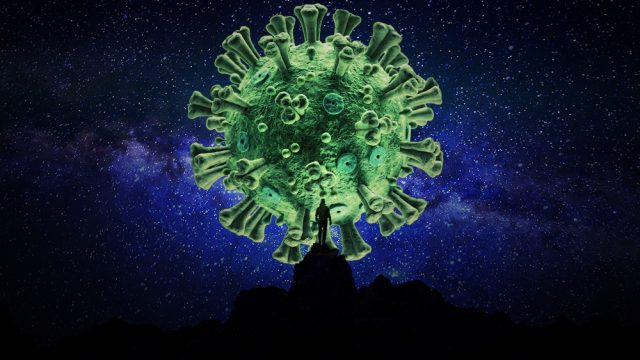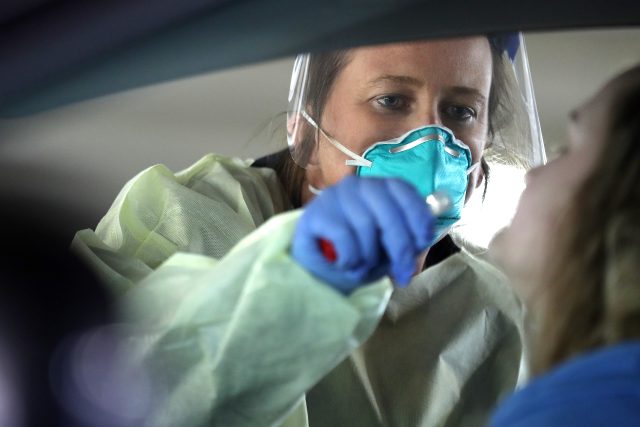
As COVID-19 cases increase sharply nationwide, some health experts are now recommending that healthy members of the public wear cloth masks when they’re out and about. The White House is reportedly expected to support that recommendation.
If they do, it would be an about-face from previous guidance on mask usage. Until now, officials at the World Health Organization, the US Centers for Disease Control and Prevention, and other agencies worldwide have discouraged the public from wearing masks unless they are sick or caring for someone who is sick. They noted that there is little evidence to support mass masking and that the limited data we do have suggests it may reduce disease transmission only marginally at best.
With evidence of benefits in short supply, experts also raised concerns about potential harms. Mask wearing may give people a false sense of security, some experts said. This may lead some members of the public to be lax about other, far more critical precautions, such as staying two meters apart from others, limiting outings, and washing their hands frequently and thoroughly.
Moreover, donning an uncomfortable, awkward mask may lead some people to touch their faces more, some argued. Any face touching has the potential to transfer virus particles from contaminated hands to entry points, such as the eyes, nose, and mouth. And even if a mask-wearer’s hands are clean to begin with, simply touching their mask could contaminate their hands if there are viral particles caught on the outside. If that’s the case, a mask wearer could then transfer virus particles from their mask to their face unwittingly—negating any benefit of having the mask. They might also transfer the virus from their mask to their environment by touching surfaces, where the virus particles could get picked up by other people.
Last, they argued, the masks that would be most effective at stopping the new coronavirus—SARS-CoV-2—are things like N95 respirators and surgical masks, which are in short supply worldwide. Without question, these should be preserved for the heroic frontline health workers, who are putting their lives at risk every day to treat patients with COVID-19 during this overwhelming pandemic.
While experts unanimously agree on that last point—that proper medical masks should go to healthcare workers first—the other points are now up for debate.
With SARS-CoV-2 now spreading widely and unchecked through communities nationwide, experts are taking a more favorable look at the limited data behind masks preventing disease spread among the public. In a recent a commentary in The Lancet, a group of UK and Hong Kong researchers argue that “there is an essential distinction between absence of evidence and evidence of absence.” And though there are no large, high-quality studies looking at public mask usage, there is some data to support mask usage.
As for potential harms of mask wearing—such as fraught face fussing and wearers relaxing other precautions—experts are now dismissing the concerns. Wearing a mask in public could keep people alert to current health risks in public, some experts say. A conspicuous mask strapped to your head is a constant reminder right over one’s nose to be mindful of possible viral transmission. And—as a bonus—if everyone wears a mask, it could lessen the chances of stigma of those who wear them because they are sick.
Of course, wearing a mask does not replace other interventions, like staying two meters apart or practicing good hand hygiene, says Joseph Allen, an expert of exposure assessment science in the Department of Environmental Health at Harvard T.H. Chan School of Public Health. “It’s just one more layer of protection.”
“The scale and scope of what we’re facing requires or mandates taking every precaution we can,” he says.
As such, some experts—Dr. Allen included—are now in favor of having the healthy public wear home-made cotton masks or other face coverings that could act as a basic physical barrier.
“It’s not as good [as medical masks], but it’s better than nothing,” Dr. Allen argues.
So with the conflicting reasoning and logic, what does the data on masks actually show? How were they dismissed before but embraced now? Here’s a rundown of pertinent data.
Transmission
First, to understand why masks could be helpful at blocking SARS-CoV-2 transmission, it’s important to understand how the coronavirus is transmitted. And, frankly, we still don’t know all the answers to this question.
So far, SARS-CoV-2 mainly appears to move from one human to another by being launched in relatively large respiratory droplets. These are unleashed when an infected person breathes, talks, coughs, or sneezes. These droplets are relatively heavy, they generally don’t travel much farther than two meters away from their launch site, and they follow a ballistic trajectory, that is, they fall toward the ground after blast off. But if they land on a person’s face before that or fall to a surface a person will soon touch, they could cause a new infection.
There’s also the possibility that SARS-CoV-2 can spread in smaller respiratory droplets called aerosols (less than 5 micrometers). These are droplets we exhale that are so small they can hang in the air for minutes to hours. Experts at the WHO and elsewhere say that the data so far suggests aerosol transmission is not the primary way the virus spreads, though it is still possible. So far, it appears aerosol transmission is mainly a concern for healthcare workers while they’re performing certain medical procedures on COVID-19 patients, such as placing a tube in their airway to aid breathing (intubation). This may create circumstances for the virus to aerosolize and linger in the air in hospital rooms.
Whether SARS-CoV-2 is aerosolized in everyday settings is still unknown and up for debate. Some experts, such as Dr. Allen, believe that it could be happening. Others are more skeptical of the idea given that infected people only infect two to three other people on average. If each COVID-19 patient were creating infectious clouds of SARS-CoV-2 wherever they went, some experts would expect the patients would infect far more people on average. Measles, for instance, has been associated with airborne transmission for decades and each measles patient, on average, may infect 12 to 18 people—or more. There’s even evidence the measles virus can disperse through ventilation systems.
Though that doesn’t appear to be the case for SARS-CoV-2, experts like Allen caution that the size of virus-containing respiratory droplets is a continuum, not subject to clear cut-offs or strict rules. There is evidence that if SARS-CoV-2 does make it into aerosols, the virus can survive in the air for hours in laboratory conditions.
Last, there’s evidence that SARS-CoV-2 particles that land on surfaces or objects can loiter and potentially be picked up by others. These contaminated surfaces and objects that can then transfer the infectious virus particles are called fomites. Masks may keep a wearer from putting a fomite-contaminated hand to their face, but masks may also act as fomites.

Filtration by N95 respirators, surgical masks, and homemade masks
N95 respirators get their name from their National Institute for Occupational Safety and Health (NIOSH) designation. They contain filter material that uses electrostatic attraction to thwart particles of all sizes. The N in the name means the masks are not resistant to oil and the 95 refers to their efficiency. To get a 95 designation, a mask has to filter out at least 95 percent of all particles. Specifically, the designation is granted if the mask proves to filter out at least 95 percent of particles in the size range it is least efficient at filtering out in standard conditions. This is considered “worst case” testing.
In one 2014 study, researchers compared the effectiveness of 44 masks, including N95 equivalent respirators, surgical and dental masks, general cotton masks, and handkerchiefs. They used particle penetration tests similar to those used by NIOSH and the European Union.
They found that the N95 equivalent mask blocked more than 95 percent of all particles, as expected. The surgical mask was around 40 percent effective, with the dental masks coming in at around 60 percent. Cotton masks were around 30 percent effective and cotton handkerchiefs ranged from 2 percent (one layer) to 13 percent (four layers).
A similar study in 2010 by NIOSH researchers looked at masks made of different types of fabrics. They found that masks made from t-shirts blocked about 10 percent of particles in a wide range, masks made from sweatshirt fabric blocked 20 to 40 percent, masks made from towels blocked around 40 percent, and scarves blocked 10 to 20 percent.
In a study published April 3, 2020 in Nature Medicine, researchers found that surgical masks reduced the detection of respiratory viruses in aerosols generated by infected people breathing or coughing in a breath-collecting machine.
Masks in the real world
Overall, the body of research on mask efficacy in real-world settings is small and scattershot. And because SARS-CoV-2 was completely unknown to humanity just five (extremely long) months ago, there is no data on the efficacy of any type of mask wearing in any setting (healthcare or home) for this virus.
As such, any relevant data has to be gleaned from studies looking at other respiratory illnesses and how various masks in various settings play a role.
Masks on healthy people
In a 2011 randomized clinical trial, researchers monitored 1,441 healthcare workers in 15 Beijing hospitals to compare the rates of respiratory infections if they wore either a surgical mask or an N95 respirator during their shifts. They compared infection rates in the two masked groups to a convenience sample of 481 healthcare workers who didn’t wear masks.
Overall, both masked groups had fewer respiratory symptoms, influenza-like illnesses, and confirmed viral infections than the control group. The rates of illness were approximately double in those who wore surgical masks compared with those who wore N95 respirators, though. For instance, about 9 percent of non-mask wearers reported respiratory symptoms compared with about 7 percent of surgical mask wearers and 4 percent of N95 wearers.
But with such small infection rates overall, there was limited power to detect differences, and the authors note that the findings may not hold up in other settings.

Masks on sick people
The push to preserve medical-grade masks for healthcare workers is intended to try to protect them from contracting illnesses from their patients. But the push for public face mask use is powered by the desire to prevent sick people from spraying respiratory droplets around and potentially sicken others.
This has become a greater concern as more evidence has pointed to apparent symptomless spread of COVID-19. That is, people who don’t show symptoms (either asymptomatic or pre-symptomatic) may be able to pass on the infection without knowing it. While there is evidence that this is happening in some cases, it’s still very unclear how often it happens. Estimates of how many cases are spreading stealthily like this have ranged from between 25 percent of cases to over 60 percent. Experts at the WHO, though, continue to say that people who are coughing or sneezing are still most likely to be the ones passing on the virus.
In a 2016 randomized controlled trial, researchers examined whether wearing a surgical mask could keep people with influenza-like illnesses (ILI) from passing the infection on to members of their household. Those household members were not asked to wear masks and the researchers didn’t collect data on it. The study included 123 ILI patients who were instructed to wear masks at home around other household members and 122 ILI patients who didn’t wear masks. The masked and unmasked ILI patients were in households with, on average, 2.5 or 2.4 members, respectively.
While the infection rates in home of masks-wearing patients were consistently lower than those in the homes of unmasked patients, the numbers were too small to be statistically significant.
“The study indicates a potential benefit of medical masks for source control but is limited by small sample size and low secondary attack rates [subsequent infections],” the authors concluded. “Larger trials are needed to confirm efficacy of medical masks as source control.”
Masks on everyone
With the current suggested policies, everyone may be wearing masks, which has also been examined in a number of studies.
In 2008, a randomized controlled trial led by researchers in Hong Kong looked at the effect of blanket mask wearing on the spread of flu within households. They started with 198 households with one confirmed case at the beginning. Of those households, 127 were told that all household members should wear masks around each other. In 35 households, members were instructed to adhere to hand hygiene protocols and the remaining 36 households were controls.The researchers found little difference in infection spread among all three groups.
In 2009, researchers led by a group in Australia followed up with a similar randomized controlled study. The group looked at the spread of influenza-like illness to 286 adults in 143 households with a sick child. Participants were either assorted into a control group, a surgical mask group, or a more protective mask. Overall, they detected no difference in infection rates among the three groups. They noted that at least half of masked participants didn’t adhere to wearing the mask.
Another randomized controlled trial in 2009 followed people in 259 households in Hong Kong. Collectively, the households started with 407 household members with flu and 794 uninfected contacts. The households were randomly assorted to either all wear surgical masks, practice hand hygiene, or act as controls. Overall, the interventions didn’t lead to statistically significant differences in the spread of infections within the households. But when they looked at households that started using masks quickly (within 36 hours) after the onset of flu symptoms in a member, they did see a statistically significant reduction in infection spread.
Likewise, in a 2012 randomized controlled trial involving 84 households in Germany, researchers again found no difference in disease spread among household members that used masks, masks and hand hygiene, or were in a control group. However, when they did a separate analysis just looking at the households who fully implemented mask wearing or mask wearing and hygiene within 36 hours of onset of symptoms in their first case, they did note a lower chance of transmission than what was seen in controls.
Cloth masks
While most studies have looked at the effectiveness of surgical masks and other medical-grade masks, a few have ventured to look at cloth and homemade masks.
In a 2015 randomized controlled trial involving 1,607 healthcare workers, researchers compared the rate of influenza-like illness in healthcare workers wearing cloth masks or medical masks to those in a control group (which sometimes used masks). Wearing cloth masks resulted in significantly higher rates of infection, the authors found. They also noted that in their test, the cloth masks were only 3 percent effective at blocking particles.
Potential risks of masks
There is evidence that virus particles hang out on the outside of masks—particularly among healthcare workers who likely have high exposure. Among 59 healthcare workers who had their protective gear, clothes, and skin sampled in a 2019 study, many were contaminated with virus. Overall, 31 percent of gloves, 21 percent of gowns, and 12 percent of face masks were positive for virus. Moreover, 11 percent had viral particles on their scrubs and 7 percent had them on their bare faces.
A similar study, also in 2019, confirmed that respiratory viruses are often found on the outside surface of medical masks and can be a source of self-contamination.
In yet another study from last year, researchers in Chicago observed healthcare workers taking off their person protective equipment (masks, gloves, gowns, etc)—the removal is called doffing. This is a time when healthcare workers can easily self-contaminate by taking gear off incorrectly. The researchers found that healthcare workers incorrectly removed their protective gear 90 percent of the time.
If you do wear a mask, be sure to remove it from behind your head. Don’t touch the surface of the mask. If you do touch the surface, immediately wash your hands or use hand sanitizer.
https://news.google.com/__i/rss/rd/articles/CBMiX2h0dHBzOi8vYXJzdGVjaG5pY2EuY29tL3NjaWVuY2UvMjAyMC8wNC9zaG91bGQteW91LXdlYXItYS1mYWNlLW1hc2staGVyZXMtYWxsLXRoZS1kYXRhLXdlLWhhdmUv0gFlaHR0cHM6Ly9hcnN0ZWNobmljYS5jb20vc2NpZW5jZS8yMDIwLzA0L3Nob3VsZC15b3Utd2Vhci1hLWZhY2UtbWFzay1oZXJlcy1hbGwtdGhlLWRhdGEtd2UtaGF2ZS8_YW1wPTE?oc=5
2020-04-03 19:45:00Z
CBMiX2h0dHBzOi8vYXJzdGVjaG5pY2EuY29tL3NjaWVuY2UvMjAyMC8wNC9zaG91bGQteW91LXdlYXItYS1mYWNlLW1hc2staGVyZXMtYWxsLXRoZS1kYXRhLXdlLWhhdmUv0gFlaHR0cHM6Ly9hcnN0ZWNobmljYS5jb20vc2NpZW5jZS8yMDIwLzA0L3Nob3VsZC15b3Utd2Vhci1hLWZhY2UtbWFzay1oZXJlcy1hbGwtdGhlLWRhdGEtd2UtaGF2ZS8_YW1wPTE
Bagikan Berita Ini














0 Response to "Face masks for COVID-19: A deep dive into the data - Ars Technica"
Post a Comment